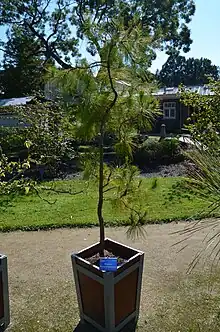Pinus tecunumanii
Pinus tecunumanii (syn. Pinus oocarpa var. ochoterenae Martínez; Pinus patula Schiede & Deppe spp. tecunumanii Eguiluz & Perry) is a timber tree native to Mexico and Central America.[1] It grows from the highlands of Chiapas and Oaxaca through Guatemala, Belize, El Salvador, Honduras to Nicaragua (17° to 14° North latitude). It occurs in two separated populations in their native habitats. The high-altitude group grows at 1500–2900 m, and the low-altitude group at 500–1500 m.
| Pinus tecunumanii | |
|---|---|
 | |
| Scientific classification | |
| Kingdom: | Plantae |
| Clade: | Tracheophytes |
| Clade: | Gymnosperms |
| Division: | Pinophyta |
| Class: | Pinopsida |
| Order: | Pinales |
| Family: | Pinaceae |
| Genus: | Pinus |
| Subgenus: | P. subg. Pinus |
| Section: | P. sect. Trifoliae |
| Subsection: | P. subsect. Australes |
| Species: | P. tecunumanii |
| Binomial name | |
| Pinus tecunumanii F.Schwerdtf. ex Eguiluz & J.P.Perry | |
The wood is yellowish. This species has been cultivated in several subtropical parts of the world for the paper industry. Cultivation trials have shown that high-elevation sources are the most productive. It grows well in Colombia, Venezuela, Brazil and South Africa.
P. tecunumanii was formerly classified as a subspecies of Pinus patula, but DNA analysis has shown that it is a different species, closer to Pinus oocarpa.
References
- Farjon, A. (2013). "Pinus tecunumanii". IUCN Red List of Threatened Species. 2013: e.T35764A2860526. doi:10.2305/IUCN.UK.2013-1.RLTS.T35764A2860526.en. Retrieved 11 November 2021.
- Dvorak, W. S., G. R. Hodge, E. A. Gutiérrez, L. F. Osorio, F. S. Malan and T. K. Stanger. 2000. Pinus tecunumanii. In: Conservation and Testing of Tropical and Subtropical Forest Species by the CAMCORE Cooperative. College of Natural Resources, NCSU. Raleigh, NC. USA. pp: 188–209.
External links
- (in Spanish) Pinus tecunumanii
